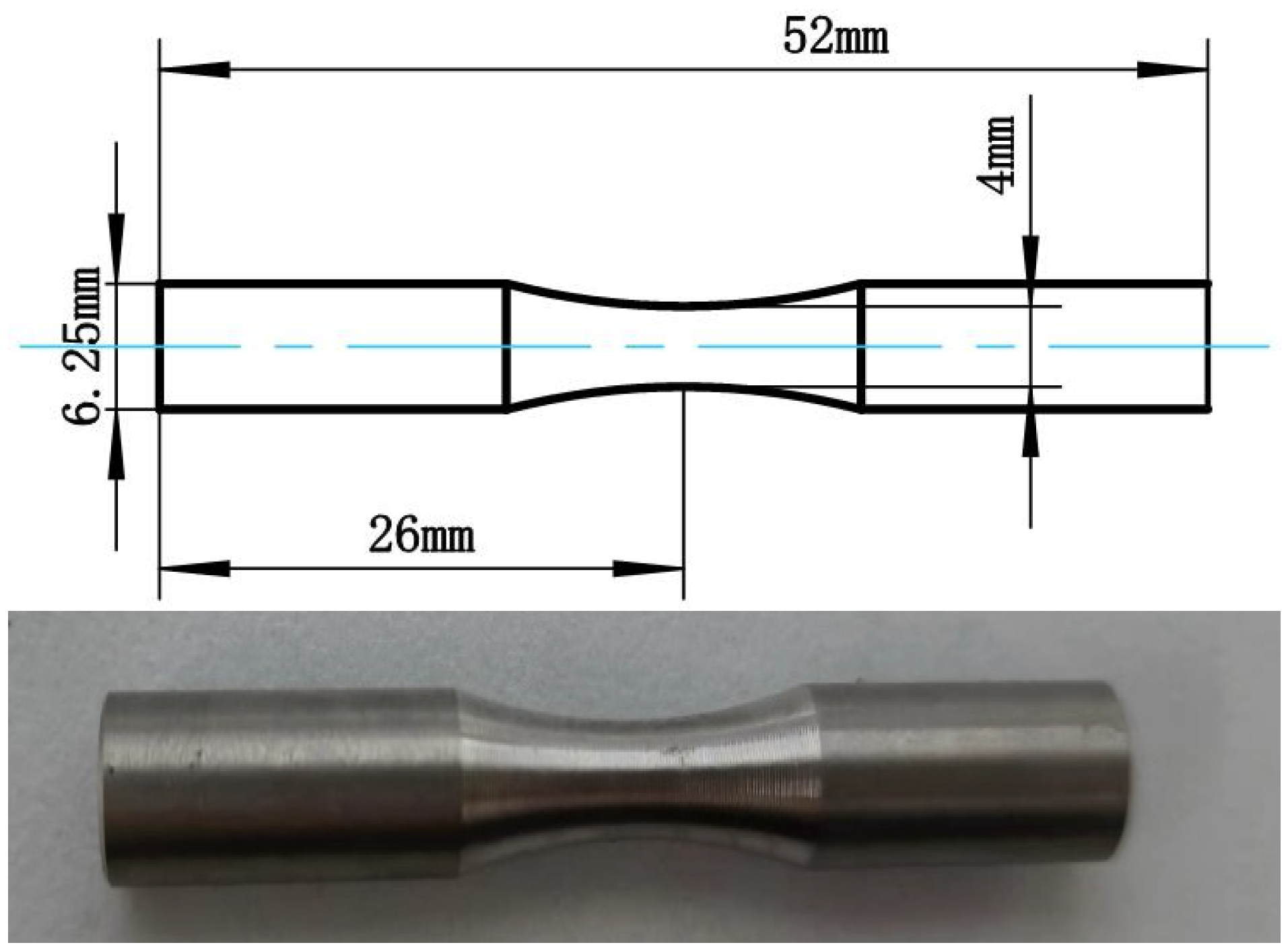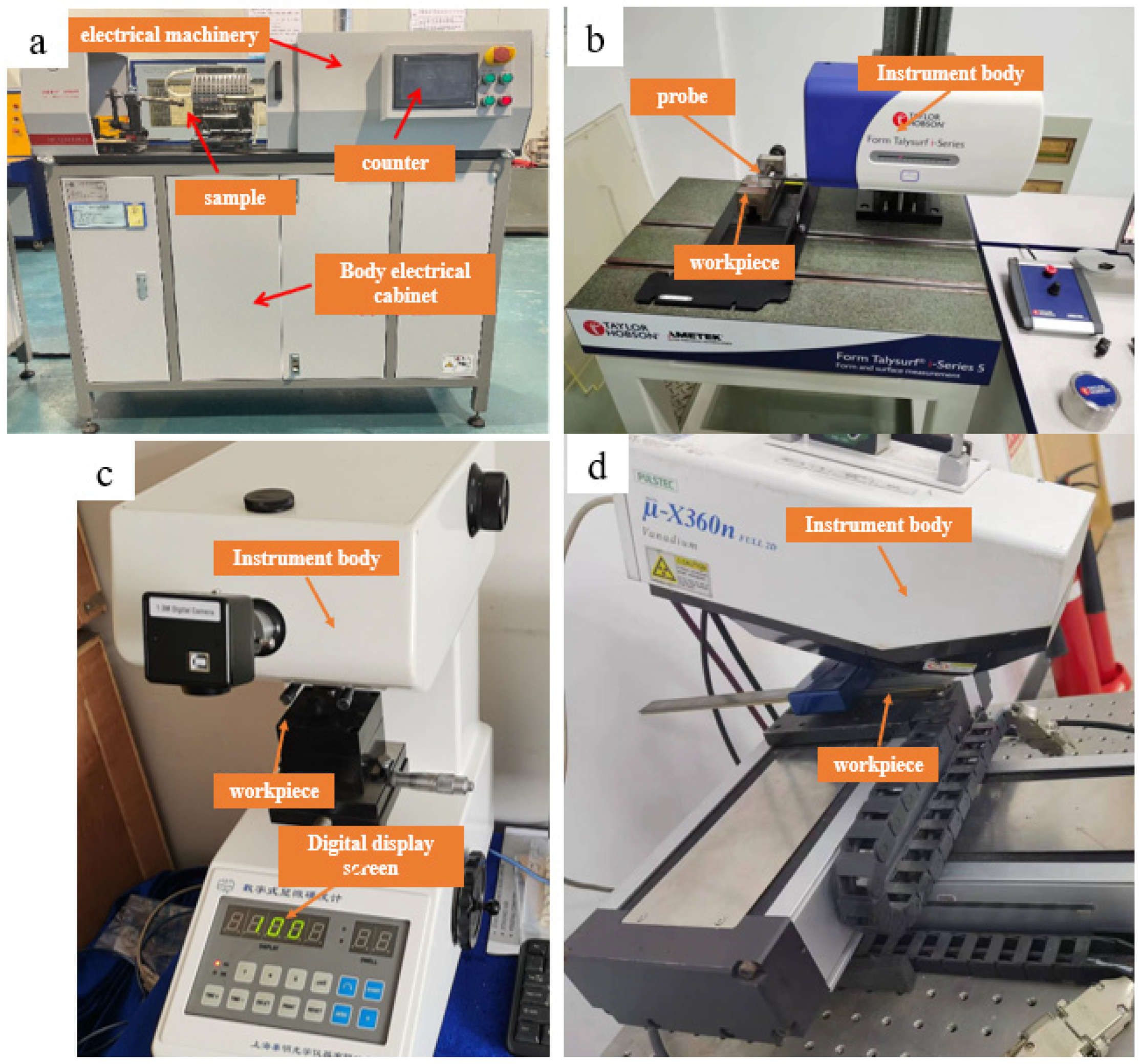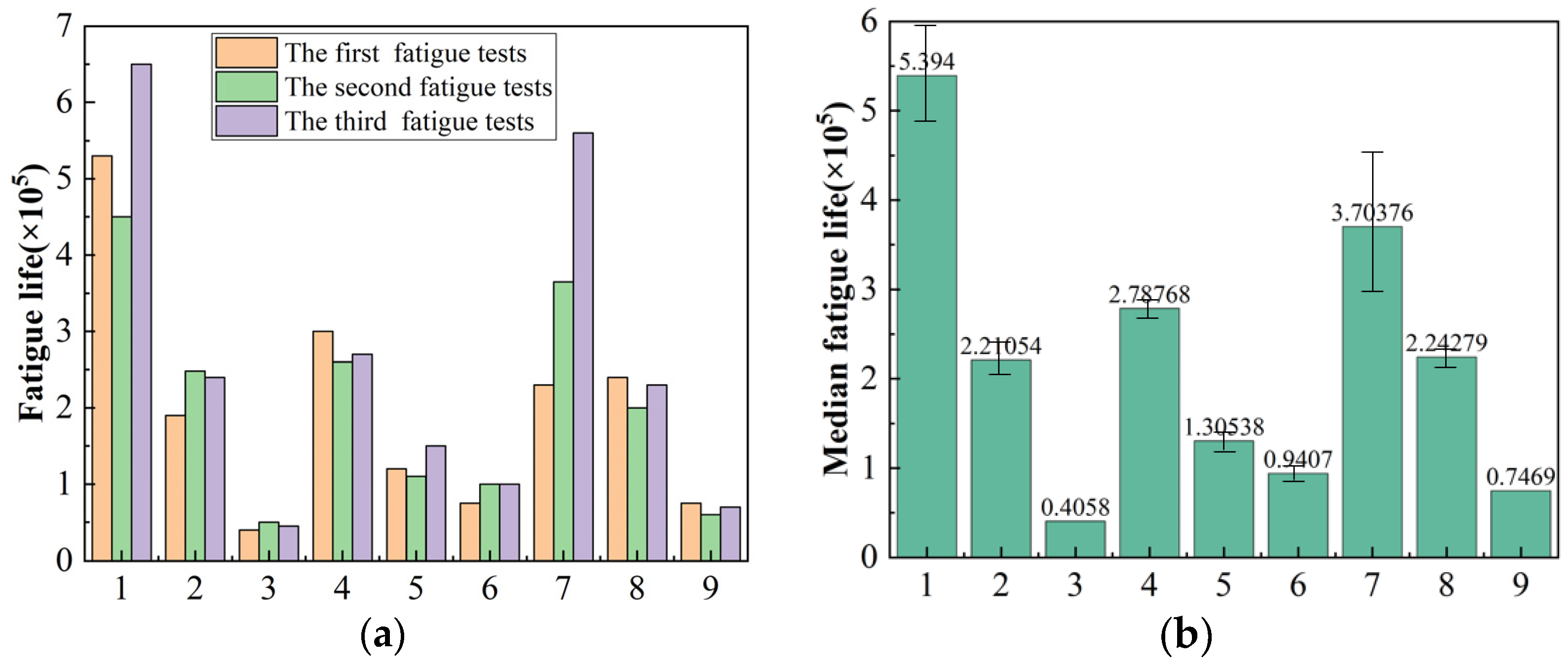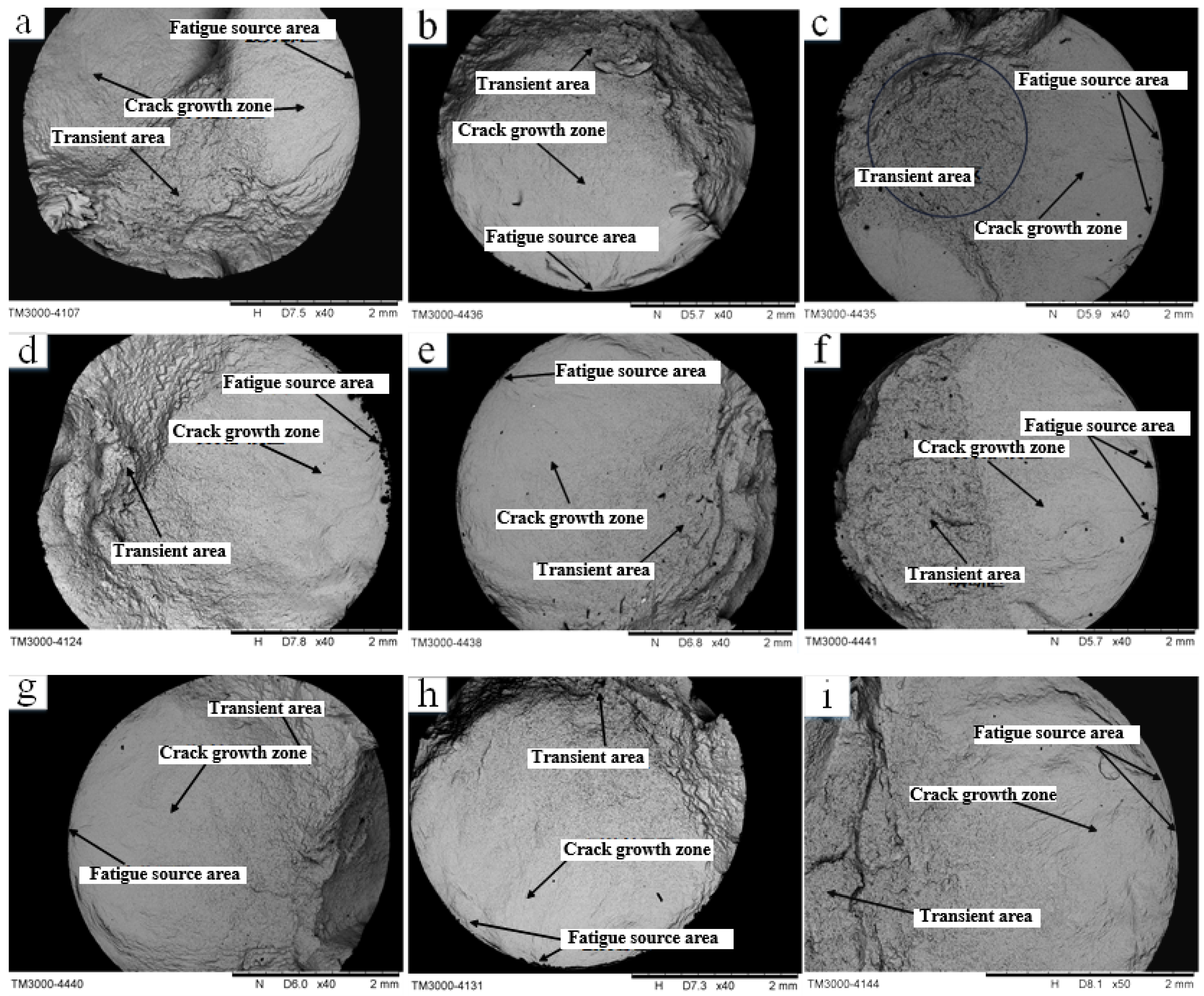Effect of Cutting Surface Integrity on Fatigue Properties of TC17 Titanium Alloy
Abstract
:1. Introduction
2. TC17 Fatigue Test
2.1. Sample Preparation and Equipment
2.2. Fatigue Test Design
3. Results and Discussion
3.1. Influence of Turning Parameters on Surface Integrity
3.1.1. Surface Roughness
3.1.2. Microhardness
3.1.3. Residual Stress
3.2. Fatigue Life Analysis
3.3. Analysis of Fatigue Fracture
3.3.1. Macroscopic Morphology of Fatigue Fracture
3.3.2. Microstructure of Fatigue Fracture
4. Conclusions
- (1)
- The rule of influence of turning parameters on surface integrity was studied, the mathematical equation between the two was summarized, the mathematical formula of surface integrity on fatigue life of materials at normal temperature was fitted according to the linear regression equation, the rule of influence on fatigue life at normal temperature within the given range of turning parameters was studied, and the mathematical equation of fatigue life of turning parameters was fitted.
- (2)
- The biggest influence on fatigue life is the microhardness of the machined surface, followed by the stress concentration coefficient and residual stress. Fatigue life increases with the increase in microhardness and residual compressive stress, and decreases with the increase in stress concentration coefficient. At normal temperature, fatigue life decreases with the increase in feed, increases with the increase in cutting depth, decreases first and then increases with the increase in cutting speed, and the sensitivity of turning parameters, in descending order, is feed, cutting depth and cutting speed.
- (3)
- The fatigue fracture morphology of the TC17 titanium alloy was analyzed, and its fracture mechanism was obtained. At normal temperature, cracks start from the surface of the sample, and no internal crack initiation is found. Secondary cracks and fatigue bands can be observed in the crack-expansion zone. With the increase in residual compressive stress, the initiation of the fatigue crack source can be reduced, which is conducive to the improvement of fatigue life, and the selection of turning parameters under actual machining is considered comprehensively.
Author Contributions
Funding
Institutional Review Board Statement
Informed Consent Statement
Data Availability Statement
Conflicts of Interest
References
- Kumar, S.M.R.; Kulkarni, S.K. Analysis of Hard Machining of Titanium Alloy by Taguchi Method. Mater. Today Proc. 2017, 4, 10729–10738. [Google Scholar] [CrossRef]
- Ramana, M.V.; Aditya, Y.S. Optimization and influence of process parameters on surface roughness in turning of titanium alloy. Mater. Today Proc. 2017, 4, 1843–1851. [Google Scholar] [CrossRef]
- Sun, J.; Huang, S.; Wang, T.; Chen, W. Research on surface integrity of turning titanium alloy TB6. In Proceedings of the CIRP Conference on Surface Integrity, Tianjin, China, 11–13 July 2018. [Google Scholar]
- Ramesh, S.; Karunamoorthy, L.; Palanikumar, K. Measurement and analysis of surface roughness in turning of aerospace titanium alloy (gr5). Measurement 2012, 45, 1266–1276. [Google Scholar] [CrossRef]
- Che-Haron, C.H. Tool life and surface integrity in turning titanium alloy. J. Mater. Process. Technol. 2001, 118, 231–237. [Google Scholar] [CrossRef]
- Sharman, A.R.C.; Hughes, J.I.; Ridgway, K. Workpiece Surface Integrity and Tool Life Issues When Turning Inconel 718™ Nickel Based Superalloy. Mach. Sci. Technol. 2004, 8, 399–414. [Google Scholar] [CrossRef]
- Darwish, S.M. The impact of the tool material and the cutting parameters on surface roughness of supermet 718 nickel superalloy. J. Mater. Process. Technol. 2000, 97, 10–18. [Google Scholar] [CrossRef]
- Liyun, L.; Jinfang, W.; Zhibiao, T.U.; Zhenhua, Q.; Zhen, Y.E. Study on the roughness of the machined surface and wear mechanism of the cutter in dry cutting aluminum alloy with YG8 cemented carbide. Manuf. Technol. Mach. Tool 2018, 6, 120–123. [Google Scholar]
- Mersni, W.; Boujelbene, M.; Salem, S.B.; Alghamdi, A.S. Optimization of the surface roughness in ball end milling of titanium alloy Ti-6Al-4V using the Taguchi Method. Proc. Manuf. 2018, 20, 271–276. [Google Scholar] [CrossRef]
- Maity, K.; Pradhan, S. Study of Chip Morphology, Flank Wear on Different Machinability Conditions of Titanium Alloy (Ti-6AI-4V) Using Response Surface Methodology Approach. Int. J. Mater. Form. Mach. Process. 2017, 4, 19–37. [Google Scholar]
- Hasçalık, A.; Çaydaş, U. Optimization of turning parameters for surface roughness and tool life based on the Taguchi method. Int. J. Adv. Manuf. Technol. 2008, 38, 896–903. [Google Scholar] [CrossRef]
- Zhao, G.; Xin, L.; Li, L.; Zhang, Y.; He, N.; Hansen, H.N. Cutting force model and damage formation mechanism in milling of 70 wt% Si/Al composite. Chin. J. Aeron. 2023, 36, 114–128. [Google Scholar] [CrossRef]
- Kumar, R.; Roy, S.; Gunjan, P.; Sahoo, A.; Sarkar, D.D.; Das, R.K. Analysis of MRR and Surface Roughness in Machining Ti-6Al-4V ELI Titanium Alloy Using EDM Process. Proc. Manuf. 2018, 20, 358–364. [Google Scholar] [CrossRef]
- Mazid, A.M.; Hasan, M.S.; Ahsan, K.B. An Investigation on Optimum Process Parameters in Terms of Surface Roughness for Turning Titanium Alloy Ti-6Al-4V Using Coated Carbide. Int. J. Eng. Mater. Manuf. 2019, 4, 137–145. [Google Scholar] [CrossRef]
- Matras, A.; Zbala, W.; Machno, M. Research and Method of Roughness Prediction of a Curvilinear Surface after Titanium Alloy Turning. Materials 2019, 12, 502. [Google Scholar] [CrossRef]
- Bouacha, K.; Yallese, M.A.; Mabrouki, T.; Rigal, J.F.O. Statistical analysis of surface roughness and cutting forces using response surface methodology in hard turning of AISI 52100 bearing steel with CBN tool. Int. J. Refract. Met. Hard Mater. 2010, 28, 349–361. [Google Scholar] [CrossRef]
- Ezugwu, E.O.; Wang, Z.M.; Okeke, C.I. Tool Life and Surface Integrity When Machining Inconel 718 With PVD- and CVD-Coated Tools. Tribol. Trans. 1999, 42, 353–360. [Google Scholar] [CrossRef]
- Che-Haron, C.H.; Jawaid, A. The effect of machining on surface integrity of titanium alloy Ti–6% Al–4% V. J. Mater. Process. Tech. 2005, 166, 188–192. [Google Scholar] [CrossRef]
- Sharman, A.R.C.; Aspinwall, D.K.; Dewes, R.C.; Clifton, D.; Bowen, P. The effects of machined workpiece surface integrity on the fatigue life of γ-titanium aluminide. Int. J. Mach. Tools Manuf. 2001, 41, 1681–1685. [Google Scholar] [CrossRef]
- Javidi, A.; Rieger, U.; Eichlseder, W. The effect of machining on the surface integrity and fatigue life. Int. J. Fatigue 2008, 30, 2050–2055. [Google Scholar] [CrossRef]
- Sun, J.; Wang, T.; Su, A.; Chen, W. Surface integrity and its influence on fatigue life when turning nickel alloy GH4169. Procedia CIRP 2018, 71, 478–483. [Google Scholar] [CrossRef]
- Lindemann, J.; Buque, C.; Appel, F. Effect of shot peening on fatigue performance of a lamellar titanium aluminide alloy. Acta Mater. 2006, 54, 1155–1164. [Google Scholar] [CrossRef]
- Syed, A.K.; Ahmad, B.; Guo, H.; Machry, T.; Eatock, D.; Meyer, J.; Fitzpatrick, M.E.; Zhang, X. An experimental study of residual stress and direction-dependence of fatigue crack growth behaviour in as-built and stress-relieved selective-laser-melted Ti6Al4V. Mater. Sci. Eng. A 2019, 755, 246–257. [Google Scholar] [CrossRef]
- Kawagoishi, N.; Chen, Q.; Kondo, E.; Goto, M.; Nisitani, H. Influence of cubic boron nitride grinding on the fatigue strengths of carbon steels and a nickel-base superalloy. J. Mater. Eng. Perform. 1999, 8, 152–158. [Google Scholar] [CrossRef]
- Liu, X.; Zhang, Y.; Zhu, J.; Li, X.; Xue, S. Fatigue lifetime prediction for oil tube material based on ABAQUS and FE-SAFE. J. Fail. Anal. Prevent. 2020, 20, 936–943. [Google Scholar] [CrossRef]
- Haitjema, H. Uncertainty in measurement of surface topography. Surf. Topogr. Metrol. Prop. 2015, 3, 035004. [Google Scholar] [CrossRef]
- Giusca, C.L.; Claverley, J.D.; Sun, W.; Leach, R.K.; Helmli, F.; Chavigner, M.P.J. Practical estimation of measurement noise and flatness deviation on focus variation microscopes. CIRP Ann. Manuf. Technol. 2014, 63, 545–548. [Google Scholar] [CrossRef]
- Podulka, P. Proposals of frequency-based and direction methods to reduce the influence of surface topography measurement errors. Coatings 2022, 12, 726. [Google Scholar] [CrossRef]










| Ti | Al | Sn | Zr | Mo | Cr | N | Fe | C | O | Others |
|---|---|---|---|---|---|---|---|---|---|---|
| Bal. | 4.9 | 2.0 | 1.9 | 4.2 | 4.2 | 0.02 | 0.10 | 0.02 | 0.10 | Each < 0.10 Total < 0.30 |
| Test Parameters | σmax | r | f | Tn | Waveform | Failure Judgment |
|---|---|---|---|---|---|---|
| Set value | 720 MPa | −1 | 83.3 Hz | 20 °C | Sine wave | Working section fracture |
| Full Name | Surface Roughness | Microhardness | Residual Stress | Cutting Speed | Feed | Cut Depth |
|---|---|---|---|---|---|---|
| Abbreviation | Ra | HV | σ | vc | f | ap |
| No. | vc (m/min) | f (mm/r) | ap (mm) | Ra (μm) | Std. (μm) | σ (MPa) | Std. (MPa) | HV | Std. |
|---|---|---|---|---|---|---|---|---|---|
| 01 | 30 | 0.05 | 0.1 | 0.34 | 0.064 | −249 | 10.756 | 405.1 | 20.543 |
| 02 | 30 | 0.15 | 0.2 | 0.95 | 0.052 | −162 | 8.523 | 440.2 | 31.953 |
| 03 | 30 | 0.25 | 0.3 | 3.51 | 0.563 | −124 | 8.498 | 471.5 | 27.146 |
| 04 | 40 | 0.05 | 0.2 | 0.77 | 0.022 | −237 | 9.275 | 421.9 | 30.523 |
| 05 | 40 | 0.15 | 0.3 | 1.12 | 0.298 | −155 | 2.543 | 437.3 | 35.148 |
| 06 | 40 | 0.25 | 0.1 | 4.99 | 1.205 | −98 | 1.988 | 421.1 | 25.857 |
| 07 | 50 | 0.05 | 0.3 | 1.45 | 0.377 | −241 | 6.726 | 429.5 | 27.288 |
| 08 | 50 | 0.15 | 0.1 | 1.93 | 0.326 | −126 | 12.287 | 416.1 | 19.244 |
| 09 | 50 | 0.25 | 0.2 | 4.68 | 1.022 | −120 | 16.283 | 431.5 | 5.248 |
Disclaimer/Publisher’s Note: The statements, opinions and data contained in all publications are solely those of the individual author(s) and contributor(s) and not of MDPI and/or the editor(s). MDPI and/or the editor(s) disclaim responsibility for any injury to people or property resulting from any ideas, methods, instructions or products referred to in the content. |
© 2023 by the authors. Licensee MDPI, Basel, Switzerland. This article is an open access article distributed under the terms and conditions of the Creative Commons Attribution (CC BY) license (https://creativecommons.org/licenses/by/4.0/).
Share and Cite
Wang, D.; Chen, X.; Lai, X.; Zhao, G.; Yang, Y. Effect of Cutting Surface Integrity on Fatigue Properties of TC17 Titanium Alloy. Materials 2023, 16, 5658. https://doi.org/10.3390/ma16165658
Wang D, Chen X, Lai X, Zhao G, Yang Y. Effect of Cutting Surface Integrity on Fatigue Properties of TC17 Titanium Alloy. Materials. 2023; 16(16):5658. https://doi.org/10.3390/ma16165658
Chicago/Turabian StyleWang, Dan, Xiyu Chen, Xunqing Lai, Guolong Zhao, and Yinfei Yang. 2023. "Effect of Cutting Surface Integrity on Fatigue Properties of TC17 Titanium Alloy" Materials 16, no. 16: 5658. https://doi.org/10.3390/ma16165658
APA StyleWang, D., Chen, X., Lai, X., Zhao, G., & Yang, Y. (2023). Effect of Cutting Surface Integrity on Fatigue Properties of TC17 Titanium Alloy. Materials, 16(16), 5658. https://doi.org/10.3390/ma16165658






